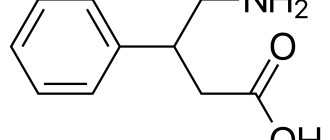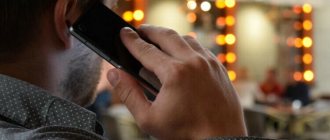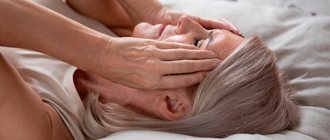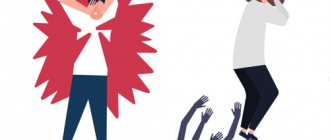What it is
A panic attack is a causeless, debilitating attack of panic or anxiety, accompanied by a feeling of fear and various physiological symptoms.
To understand what a person feels at such moments, imagine the situation. You are walking down the street and suddenly notice that a huge dog is rushing towards you at a frantic pace. There is an ominous grin on his face, his gums are exposed and his sharp, huge fangs are visible. Drool splashes in all directions, and rage and malice are visible in his eyes. How do you feel?
Of course, you will experience incredible fear, you will feel that your heart has stopped, your legs have become weak, and sweat has appeared on your forehead. People experiencing a panic attack feel about the same thing. But there is a colossal difference between you and them: in your case there is a real threat to life, while for them there is no objective danger. That is, their fears are not supported by anything.
However, this is only at first glance; such individuals can say that the attack began suddenly. In further conversation with them, it turns out that panic was preceded by traveling in an elevator or public transport, being in a place with a large crowd of people or on an airplane, or other similar reasons.
The concept of “panic” originates from the name of the god Pan, the lord of fields, forests and herds. According to legends, he suddenly appeared before a person covered in fur and with goat legs, plunging the latter into uncontrollable fear. The man started to run, not knowing where, along the edge of a cliff, not realizing that flight could also threaten death.
In the literature one can find the concepts of vegetative or sympathoadrenal crisis, cardioneurosis. They are identical to the term “panic attack.”
Why does a panic attack happen?
The reasons for this condition have not been fully elucidated. There are many prerequisites and provoking factors that can theoretically cause such a hypertrophied feeling of anxiety.
They are divided into biological, psychological and physiological.
Biological reasons include:
- hormonal changes during puberty, menopause, childbirth;
- beginning of sexual life;
- menstrual irregularities;
- heredity.
Panic attacks develop against the background of certain disorders:
- pheochromocytoma – hormonal tumor;
- psychosomatic disorders;
- phobias;
- depression;
- post-traumatic stress disorder;
- endocrine diseases;
- heart pathologies.
Among the psychological precursors of the condition are:
- acute stress - death of a loved one, divorce, any negative sudden situation;
- identification or opposition of oneself to any subject - the hero of a film, book, etc.;
- isolation from society;
- character traits;
- childhood experience.
As for character traits, most often panic attacks accompany women with a hysterical, demonstrative personality type. They constantly attract attention and crave recognition. Such women often have an extravagant appearance, are pretentious and very expressive. If they notice that they are not of interest to the “victim,” they very quickly switch to another object.
Men suffering from this disease exhibit traits called “health hypochondria.” They care very much about their appearance and strive to always look perfect.
Stress experienced in childhood also contributes to the development of attacks of fear already at a conscious age. One of the common causes is alcoholism in the family, which provokes situations of aggression. It could be a fight, a risk of murder. The situation becomes so acute that they have to flee home, often at night. In this case, fear is fixed, and in adulthood, in similar situations, it is repeated in such an impartial manner, intensified several times.
Another example is families where children grow up in conditions of emotional poverty and coldness. When parents or a parent (if we are talking about a single-parent family) are so passionate about themselves and their work that they simply don’t get around to the child. Or in the case when someone close to you suffers from a serious illness, everything revolves around the sick person, and they simply forget about the child.
Emotional coldness towards a child is present where too great demands are placed on him. At the same time, parents can keep the child under super control, but, at the same time, not show warmth and kindness towards him. Adults raised in such circumstances constantly seek approval and emotional support. Their stress resistance is significantly reduced.
The third model of family behavior is the opposite of the previous one and is based on overprotection of the child. At the same time, his parents are constantly worried about his condition, regarding any situation as potentially dangerous. They control literally all areas of their “blood” and try to accompany him everywhere. By doing this, they support the child’s infantilism, which leads to difficulties in social adaptation.
Constant conflicts in the family develop emotional lability in the child. The inability to influence the situation provokes confidence in one’s helplessness.
Any of the listed models lead to the fact that such a child grows into an adult who is emotionally unstable, insecure, and has difficulty interacting with society. This reduces his resistance to stress, exposing him to all sorts of mental disorders.
In addition to family conflicts, violence experienced in childhood, sexual or physical, contributes to the development of panic attack syndrome.
Physiological factors that provoke an attack include abuse of alcoholic beverages and psychostimulants, physical fatigue, weather changes, and excess solar radiation.
The incredibly talented actor Johnny Depp suffers from panic attacks. According to him, since childhood he has experienced anxiety in any non-standard situation. And the choice of his eccentric roles is nothing more than an attempt to hide his essence in front of millions of viewers.
Cause of morning insomnia
What can cause unwanted
early morning awakenings?
The most common cause is
anxiety and
depression, the presence of which provokes premature awakening in the morning. Almost all depression and most anxiety disorders have sleep disturbances in the form of early awakenings.
Any of the mood disorders (depression, mania, anxiety), which have in their context symptoms of excessive anxiety or low mood, can provoke awakenings, which most often occur several hours before the expected awakening. For example, if the alarm is set to 6 a.m., a depressed person may begin to wake up at 4 a.m. for no apparent external reason.
Signs of the syndrome
A panic attack usually develops suddenly. And he can find the patient anywhere, at any time of the day. Its manifestations vary: from an uncontrollable, painful feeling of fear and anxiety to internal discomfort. A panic attack with mild symptoms is called “panic without panic.” In this case, physiological symptoms dominate.
The duration of the attack may be only a few minutes, in other cases it lasts several hours. But on average its duration is 20–30 minutes. PAs are repeated in one situation 1–2 times a day, in others – several times a month. Having experienced such sensations for the first time, a person retains the memory of them for the rest of his life.
There is an incredible accident when a patient experiences attacks only a couple of times in his entire life. They disappear without a trace, presumably after the stress factor ends.
A panic attack is accompanied by the following symptoms:
| Psychological | Physiological (vegetative) |
|
|
The first case of a panic attack is expressed by an extremely strong fear of dying. Its power is so powerful that it can drive the patient into a state of passion. In subsequent cases, the feeling of imminent death is transformed into a specific phobia. This could be a fear of going crazy, suffocating, etc.
There are situations when the condition is not accompanied by an anxiety-phobic complex. Emotional symptoms come to the fore: apathy, a feeling of uselessness, aggression, nervousness.
After a paroxysm, patients feel exhausted and overwhelmed.
Panic attacks most often occur between the ages of 25 and 50. Approximately 5% of humanity suffers from the pathology. And what’s interesting is that they are mostly residents of large cities. In old age, such paroxysms occur rarely, have an erased character and become remnants of attacks that occurred in youth.
Those who have experienced a similar condition at least once in their lives describe it with horror and excitement.
For example, a girl had an attack while she was driving in a car with her husband and child. There was a feeling of lack of air, an unreal horror ran through from head to toe. In an instant there was a desire to open the door and jump out of the salon. The busy highway held me back.
Another patient was seized with fear when certain sounds appeared. I felt a nasty tingling sensation in my palms. Excitement sets in, causing your thoughts to become confused and your tongue to be taken away.
A woman described her husband experiencing a panic attack while they were walking in the park and talking about a relative who had recently had a heart attack. She noticed that her husband's arms and shoulders suddenly began to shake. He was covered in sweat, it was even dripping. His face turned pale, he practically stopped breathing (he couldn’t take a breath), his gaze was wandering and unconscious. The man was sure he was dying. It took almost 2 hours to get home, whereas it usually took 20 minutes. He constantly stopped, sat down on the ground, and the attack repeated.
Anxiety and Anxiety Disorders
16.05.2019
Psychologist's advice
Marusyak Olga Ivanovna
Anxiety disorders are by far the most common of the officially classified mental illnesses, especially in developed countries: in the United States, Europe, even ahead of depression and other mood disorders. It is unlikely that anyone today would argue with the fact that chronic stress is a distinctive feature of our era and that anxiety has become a kind of cultural phenomenon of our time. According to some modern researchers, we live in an era of anxiety. Anxiety is based on a person’s perception of the surrounding reality as unstable, unpredictable and threatening.
Interestingly, in the first half of the 20th century, anxiety simply did not exist as a clinical category. In 1950, psychoanalyst Rollo May noted in his book “The Meaning of Anxiety” that by that time only two thinkers had considered it necessary to write a separate work on anxiety: Søren Kierkegaard and Sigmund Freud.
Freud called anxiety “a mystery, the solution of which should throw light on our entire mental life.” By unraveling the mystery of anxiety, he believed, we would take a huge step toward penetrating the mysteries of the mind—consciousness, ego, personality, intellect, imagination, creativity, not to mention pain, suffering, hope, and regret. To understand anxiety is, in a certain sense, to understand human nature as such.
Nowadays, thousands of scientific papers are written about anxiety every year, and several specialized scientific journals are entirely devoted to it. Anxiety researchers are constantly making new discoveries concerning, in addition to the causes and methods of treating anxiety itself, the principles of the functioning of consciousness in general, the relationships between body and mind, genes and behavior, molecules and emotions. Functional magnetic resonance imaging (fMRI) has made it possible to associate subjective emotions with specific areas of the brain and even distinguish different types of anxiety based on the observed manifestations of brain activity.
Anxiety can be considered simultaneously as a phenomenon of biology and philosophy, body and spirit, instinct and reason, personality and culture. Anxiety, experienced as a sensation on a spiritual and psychological level, is amenable to scientific measurements at the molecular and physiological level. It is generated by both heredity and environment. This is both a psychological phenomenon and a sociological one. With all the richness and diversity of cultural characteristics, one cannot help but note the deep commonality of experiences at different times among different peoples, which speaks of the universality of anxiety as a property of human nature.
It is important to distinguish between the concepts of fear and anxiety. Fear is an unpleasant feeling caused by the feeling of danger, threat, or likelihood of causing pain coming from someone or something. Anxiety is a feeling of restlessness, nervousness and discomfort, usually in relation to an event or phenomenon with an uncertain outcome. If fear has a specific object, then anxiety has nothing like it.
Anxiety can be regarded as a normal reaction to a stressful situation because it helps to cope with it. If the anxious state is due to some external reasons, for example, if we are talking about concern for the health and well-being of a loved one who may be in danger, then researchers tend to consider such anxiety normal. However, over time, it can intensify and paralyze, and even disrupt the course of a person’s life, in which case anxiety is recognized as pathological. If anxiety becomes constant, then we can talk about an anxiety disorder. Almost all of us experience anxiety at some point in our lives, as it is a common reaction to real-life events, but not everyone develops long-term problems associated with anxiety.
Freud was the first to distinguish between “normal anxiety” (anxiety about a real threat can be productive) and “neurotic anxiety” (caused by unresolved sexual problems or internal mental conflicts, pathological and counterproductive). Unlike fear caused by “real” external threats, anxiety is generated by internal threats. Anxiety and panic symptoms serve as a so-called “protective shield” (“neurotic defense”) against the unbearable pain that occurs when faced with losses, awareness of mortality, or threats to self-esteem.
Anxiety can arise for no apparent reason, but everyone’s fear is related to a specific situation. Anxiety (excitement, worry) is an unpleasant, vague feeling of apprehension that arises in response to unclear or unknown threats. In other words, anxiety, most often, is pointless and is based only on our assumptions. For the sake of objectivity, it must be said that anxiety and fear are interrelated: fear often causes anxiety, and anxiety can cause fear.
An anxiety-ridden person feels like he has to run somewhere, do something urgently, but he doesn’t know how. At the same time, fear arises that there are no levers of influence on what is happening. Subsequently, the feeling of anxiety increases and reaches a state of panic, after which a person may feel complete emptiness, powerlessness, anger, and indifference. However, as soon as new forces appear, this cycle repeats again.
Alarms rarely, if ever, carry any new or useful information. They only restate possible difficulties that a person already knows about, or warn about hypothetical events that are unlikely or exaggerated. It is impossible to turn off the brain, and there is no easy way to stop the flow of anxious thoughts. This gives them the opportunity to lure you into their trap. Trying to stop the flow of anxious thoughts almost always makes the problem worse, rather than eliminating it. The trap of anxiety is this: a person is overcome by doubts, but he reacts to them as a threat.
Essentially, anxiety is the emotional experience of the unpredictability of the future. A person wants certainty of the future, but it is impossible to make the future guaranteed to be the way one wants to see it. Thus, anxiety is a tool for interacting with the future. And therefore it cannot be perceived unambiguously.
On the one hand, the experience of anxiety is unpleasant because this feeling causes discomfort. On the other hand, anxiety signals that something is wrong in life, and first of all it is a signal not about real, but about possible problems.
The criteria for the pathological nature of anxiety are:
- excessive intensity;
- unusual content;
- inadequacy of the situation (the duration and intensity of anxiety does not correspond to the situation that caused it);
- chronic repetition of obsessive thoughts or behavior;
- inability to overcome fear;
- significant changes in lifestyle, often avoiding many life situations, block personal development, communication, and activity.
Constant anxiety often causes the development of other disorders: depression, psychosomatic disorders. Anxiety often accompanies:
- diabetes;
- cardiovascular diseases, since the heart is especially sensitive to emotional stress;
- bulimia and obesity;
- gastrointestinal diseases;
- hypertension (which is associated not only with suppressed anger, but also with anxiety);
- asthma (anxiety combined with lack of self-confidence);
- frequent urge to urinate.
In addition, anxiety is an important symptom in depression, hallucinatory-delusional disorders, senile psychosis, alcoholism and other drug addictions.
Physical manifestations of anxiety include:
- cardiopalmus;
- tachycardia;
- muscle weakness;
- voltage;
- nausea and abdominal pain;
- chest pain;
- shortness of breath;
- headache.
In some cases, these manifestations can lead to a panic attack. Panic attacks come without warning and are subjectively perceived as a real danger.
Emotional manifestations of anxiety include:
- feeling of apprehension, fear;
- tension, irritability, anxiety;
- feeling of devastation;
- nightmares in dreams;
- obsessive ideas about unpleasant sensations;
- deja vu;
- absorption by a feeling of fear.
Cognitive manifestations:
- decreased concentration;
- waiting for signs of danger.
Theories of anxiety and approaches to its treatment can be divided into four main categories:
- psychoanalytic;
- cognitive-behavioural;
- biomedical;
- empirical.
According to the psychoanalytic approach , anxiety is caused by the suppression of taboo thoughts and ideas or internal mental conflicts. The treatment is to bring these deep-rooted conflicts into the conscious area.
In cognitive behavioral therapy, anxiety is considered a conditioned response. Anxiety disorders occur when we develop (often through unconscious learning) a fear of objectively harmless objects or events, or excessive fear of a small threat. Treatment involves correcting incorrect thinking.
The biomedical approach addresses the biological mechanisms of anxiety - brain structures such as the amygdala, hippocampus, locus coeruleus, anterior cingulate cortex and insula, as well as neurotransmitters (serotonin, norepinephrine, dopamine, glutamate, gamma-aminobutyric acid (GABA) and neuropeptide Y (NPY) )) and genetics, which encodes all this. Treatment is often done with medication.
Representatives of the empirical school adhere to the existential principle, considering panic attacks and obsessive anxiety to be defense mechanisms that the psyche develops when its integrity or self-esteem is threatened. The empirical approach, like the psychoanalytic one, attaches great importance to the essence and content of anxiety (in contrast to the biomedical and behavioral approaches that deal with its mechanisms), looking for clues to hidden psychotrauma or the conviction of the futility of one’s own existence.
However, despite numerous disagreements, all these theories and directions are not exactly mutually exclusive. In many ways they overlap.
Anxiety disorders include:
- panic disorder;
- generalized anxiety disorder;
- social anxiety disorder;
- obsessive-compulsive disorder;
- agoraphobia;
- post-traumatic stress disorder;
- specific phobias.
Panic disorder
The main symptom is repeated attacks of severe anxiety (panic) that are not limited to a specific situation or circumstance and are therefore unpredictable. Dominant symptoms:
- sudden palpitations;
- chest pain;
- feeling of suffocation;
- dizziness;
- feeling of unreality;
- fear of death, loss of self-control, or madness.
The attacks usually last only minutes, although at times they last longer. If this occurs in a specific situation, such as on a bus or in a crowd, the person may subsequently avoid that situation. Likewise, frequent and unpredictable panic attacks cause fear of being alone or being in crowded places. A panic attack often leads to a constant fear of another attack occurring. Symptoms of a panic attack can resemble a heart attack.
There are three types of panic attacks: unexpected, situationally limited and situationally predisposed.
Factors such as stressful life events, life changes, and a stressful environment play a significant role in panic disorder, but genetic factors are also important. People who tend to take on excessive responsibility may be prone to panic attacks.
Some researchers indicate that diseases such as hypoglycemia, hyperthyroidism, mitral valve prolapse, pheochromocytoma and respiratory system disorders can cause or aggravate panic disorders. In addition, among biological factors, various changes in hormonal levels can be noted.
To make sure that physical symptoms are truly signs of panic attacks and not some kind of disease, you need to undergo a medical examination. This is a necessary and very important point, since similar symptoms can be observed in some somatic diseases: heart rhythm disturbances (arrhythmias) and cardiovascular diseases; arterial hypertension (hypertension); respiratory diseases; diseases of the endocrine glands; types of epilepsy and cerebrovascular disorders.
To reduce the symptoms of panic attacks in general, you need to do the following: accept that panic attacks are not life-threatening; do not wait with fear for the next attack; train yourself to manage emotions in everyday life; lead a healthy lifestyle; do not try to avoid situations that cause fear; master relaxation techniques and get rid of negative thoughts; pay attention to your own actions that relieve or alleviate panic attacks, and apply them.
Generalized anxiety disorder
The main feature is anxiety, which is general and persistent, not limited to any specific circumstances (that is, it is “unfixed”). Frequent complaints are a feeling of constant nervousness, trembling, muscle tension, sweating, palpitations, dizziness and discomfort in the epigastric region. Fears are often expressed that the person himself or his relative will soon get sick, or that an accident will happen to them, as well as other various worries and forebodings. This disorder is more common in women and is often associated with chronic environmental stress.
Generalized anxiety disorder involves worrying about different areas of life. There are no specific targets for fear, but anxiety can be used to avoid pain associated with important areas of life. Essentially, it is the tendency to worry about everything all the time. A person tries to imagine all the possible negative consequences of any event and come up with ways to prevent them. The disorder is often accompanied by physical symptoms of stress: insomnia, muscle tension, digestive problems, etc.
Social anxiety disorder
Social phobias often begin in adolescence and center around the fear of experiencing attention from others in relatively small groups of people (as opposed to crowds), which leads to avoidance of social situations. Unlike most other phobias, social phobias are equally common in men and women. They can be isolated (for example, limited only to fear of eating in public, public speaking, or meeting with the opposite sex) or diffuse, including almost all social situations outside the family circle. The fear of vomiting in society may be important. In some cultures, direct face-to-face confrontation can be especially frightening.
Social phobias are usually combined with low self-esteem and fear of criticism. They may present with complaints of facial flushing, hand tremors, nausea, or an urge to urinate, sometimes with the person convinced that one of these secondary expressions of their anxiety is the underlying problem; symptoms can progress to panic attacks. Avoidance of these situations is often significant, which in extreme cases can lead to almost complete social isolation.
Social anxiety can affect people in a variety of ways, from intense emotional problems to physical effects such as a panic attack. It may include: palpitations; sweaty palms; narrowing of peripheral vision; fever or shaking; loss of concentration; slurred speech; heavy sweating.
Social anxiety disorder is divided into two types: specific and general.
For those suffering from specific social phobia, anxiety is caused by very specific circumstances, almost always associated with some type of public speaking. The most common specific social phobia is fear of public speaking, but fear of eating in public, fear of writing in public, and fear of urinating in a public toilet also fall into this category.
For those suffering from general social phobia, any social interaction causes stress. A severe form of phobia turns life into an ongoing nightmare. The most banal social interaction inspires horror. Many social phobes are forced to live as hermits.
Shame, apparently, serves as a basic emotion here - a motivating force for anxiety. Normal social anxiety and the bashful blush it causes may serve as mechanisms of evolutionary adaptation: the behavior they reinforce contributes to the maintenance of social norms.
It should be noted that there are different opinions regarding social phobia. Critics say there is another name for the syndrome that affects all sufferers of social anxiety disorder. Shyness is a common temperamental characteristic that does not in any way point to mental illness. Some degree of nervousness when interacting with strangers is quite normal. However, the stress that people with social phobia experience is very real and intense.
Albert Ellis and Aaron Beck, the founders of rational emotive behavior therapy (REBT) and cognitive behavioral therapy (CBT), respectively, argued that treating social anxiety ultimately comes down to overcoming the fear of disapproval. To overcome social phobia, you need to harden yourself from excessive shame.
The second important point is that a person suffering from social phobia is physiologically tuned to hypersensitivity to criticism. This is often associated with the expectation of being judged.
Here are some tips you can use to start taking small steps towards managing your social anxiety: attend events with as few people as possible; remind yourself more often of your positive qualities; practice more in the art of conversation; The most important thing is to be patient with yourself and communicate more with people who are sympathetic to this problem.
Obsessive-compulsive disorder
The main feature is repetitive obsessive thoughts or compulsive actions.
Obsessive thoughts are ideas, images that come to mind again and again in a stereotypical form. They are almost always painful, and the person often tries unsuccessfully to resist them. Frequent all-consuming, frightening thoughts and images have a very strong and intense impact. Compulsive actions or rituals are stereotyped behaviors that are repeated over and over again. They do not provide intrinsic pleasure and do not lead to the completion of intrinsically rewarding tasks. Their meaning is to prevent any objectively unlikely events that cause harm.
This often manifests itself as time-consuming habits that seem necessary to prevent potential “disasters.” This could be repeating certain phrases in your head, rituals (like washing your hands), or following strict rules.
Typically, although not necessarily, such behavior is perceived as meaningless or fruitless, and the person makes repeated attempts to resist it. Autonomic symptoms of anxiety often occur, but painful feelings of internal or mental tension are also common.
There is a genetic predisposition to obsessive-compulsive disorder. In addition, OCD symptoms often begin to appear after a life change or stressful period.
A few simple things that help you get out of this repeating circle: increase your attentiveness to automatic actions, make them conscious (while commenting on the action out loud: “The iron is turned off. The door is closed”); practice relaxation and auto-training methods (this allows you not only to relax, but also to come to a state of calm); think about good things more often; learn to switch to another activity, since the main problem with OCD is getting stuck; remove any cause for concern (don’t watch the news, for example).
On a deeper level, it is important to work with the theme of control. The desire to exert excessive control over one’s life inevitably leads to an increase in anxiety.
Agoraphobia
The term includes a whole set of interrelated and usually overlapping phobias, covering fears of leaving the house: entering shops, crowds or public places, or traveling alone on trains, buses or planes. Some people become completely housebound. Many are terrified at the thought of falling and being left helpless in public. Lack of immediate access to an exit is one of the key features of many agoraphobic situations. Most patients are women.
Agoraphobia literally means “fear of the marketplace” in Greek. Today, this term denotes not only the fear of open space, and other similar situations (such as the presence of a crowd, the inability to immediately return to a safe place, usually home), in some cases, its opposite - claustrophobia (fear of enclosed and limited spaces).
People suffering from agoraphobia are afraid to leave their home unaccompanied, use public transport (especially the subway) and visit crowded public places. As a rule, they are afraid of the appearance of disturbing symptoms in these places and situations: dizziness, a feeling of lightheadedness, rapid heartbeat, difficulty breathing. Fears are intensified by thoughts that they will not be able to cope with these sensations and the resulting condition and get help in time.
People who have had a panic attack in a certain place may begin to avoid that particular place for fear of having another attack. Those who experience this in a large shopping center may stop going to stores altogether. Traveling on public transport, waiting in a traffic jam, or being in a crowd can trigger memories of having an attack in a similar situation (or similar place), so avoidance of such places becomes a means of preventing the fear from worsening.
With the repetition of a specific situation, a person begins to have panic attacks, and develops a fear of this situation and a desire to avoid it. completely unconsciously, a person connects panic with some past event and the place where it happened, even if this place itself no longer threatens us.
An important task is to work with a person’s usual avoidance reaction; understand the nature of panic attacks and panic neurosis, as well as the vicious circle of “fear of fear” and “fear of illness”; learn to resist symptoms of fear and panic attacks; develop a certain attitude towards your physical sensations that give rise to fear, and learn to correctly evaluate the true meaning of these sensations; gradually learn to meet circumstances that were previously avoided, trying to regularly and consistently overcome your fear in increasingly difficult situations.
Post-traumatic stress disorder
Occurs as a delayed and/or protracted reaction to a stressful event or situation (short-term or long-term) of an exceptionally threatening or catastrophic nature, which in principle can cause general distress in almost any person (for example, natural or man-made disasters, battles, serious accidents, etc.) .P). The human reaction includes intense fear, helplessness or horror.
Typical features include episodes of re-experiencing the trauma in the form of intrusive memories, dreams, or nightmares, accompanied by chronic feelings of numbness and emotional dullness, withdrawal from others, lack of responsiveness to the environment, anhedonia, and avoidance of activities and situations that are reminiscent of the trauma. Typically, a person fears and avoids what reminds him of the original trauma. Sometimes there are dramatic, acute outbursts of fear, panic, or aggression, triggered by stimuli that trigger an unexpected memory of the trauma.
A traumatic event may be experienced in one of the following ways: recurrent, intrusive anxiety associated with memories of the traumatic event (including images, thoughts, perceptions); a feeling of a repeating traumatic event - “reliving”, illusions and memories of individual episodes; experiencing stress and strong physical reactions when certain signals appear that remind you of this event.
A person tries to avoid memories of the trauma: avoids thoughts, feelings, conversations related to it; unable to remember important aspects of the injury; a noticeable decrease in interest in what is happening in the present; a feeling of detachment, alienation from other people; poverty of emotions. In addition, the following symptoms are noted: difficulty falling asleep, maintaining sleep; irritability, outbursts of anger; difficulty concentrating.
The main feeling that a traumatic event causes is a feeling of helplessness. Memories of the event may arise completely unexpectedly, causing intense fear
Group therapy becomes very important because finding a safe place to share your pain and horror with others plays a big role in dealing with trauma. This type of therapy helps a traumatized person begin to feel connected to people again.
Specific phobias
These are phobias that are limited to strictly defined situations, such as being around certain animals, heights, thunderstorms, darkness, flying in airplanes, enclosed spaces, eating certain foods, being treated by a dentist, the sight of blood or injury, and the fear of being exposed to certain diseases. Even though the triggering situation is isolated, getting into it can cause panic as in agoraphobia or social phobia. Specific phobias usually begin in childhood or young adulthood and, if left untreated, can persist for decades. The number of fears described by medicine exceeds several hundred. The content of phobias, like real human fears, is extremely diverse.
Make an appointment
Development mechanism
No one can reliably explain the pathogenesis of a panic attack. But there is a theory according to which the trigger is negative thoughts when they accidentally visit a person. Their action, akin to an objective threat, provokes the release of adrenaline and similar substances. They constrict blood vessels, causing increased heart rate and breathing. Blood pressure increases, and even in those who, in principle, do not suffer from this, the indicators reach 200 mm Hg. Art.
The amount of carbon dioxide in the blood decreases, and symptoms of hyperventilation, that is, breathing problems, increase. Receptors that cause excitation are stimulated and those responsible for inhibition are blocked. Thus, there is an increase in anxiety and panic symptoms and feelings of fear.
Many patients suffering from this disease are very afraid of losing consciousness. But in a panic crisis this is unlikely. All its development mechanisms indicate the opposite. In this state, the unconditioned “fight or flight” reflex is activated, which accompanies a frightening situation. In addition, high blood pressure and intense heartbeat simply will not allow you to do this.
Fear of fainting causes the patient to experience numbness in the limbs and dizziness. They are what confuse you.
Night PA
A panic attack can strike a person at any moment, even at night. At night, in silence and in the dark, when the patient has nothing to distract himself with, he concentrates on his thoughts of a varied nature, including negative ones.
Another reason is nightmares. But do not confuse the attack itself with a terrifying dream. Paroxysm develops after a nightmare has been seen. And it cannot be forgotten, unlike a dream.
If we are talking about panic attacks of falling asleep, then they most often occur between 00.00–4.00 in the morning. The attack can also awaken its victim in the middle of sleep.
Nighttime PA significantly undermines human health. He suffers from sleep disorders, usually insomnia or problems falling asleep.
Insufficient rest at night provokes headaches and chronic fatigue during the day. The patient's productive activity decreases. He becomes nervous and irritable. The mood becomes depressive.
The symptoms of night attacks repeat the typical manifestations of the condition and also contribute to the development of phobias. So, after the death of her father, the girl began to have panic attacks. She noted that she experienced respiratory spasms at night. Often the thought appeared that he might not wake up. She even asked her friends to call in the morning to check if she was alive.
If a person, during a paroxysm at night, feels disconnected from reality and does not understand what is happening to him, then this feeling persists during the day. An exhausted nervous system that did not have time to recover overnight does not perceive objective reality. The patient does not understand who he is and what is happening to him.
A panic attack of awakening occurs early in the morning. The patient wakes up from a sudden and overwhelming feeling of anxiety. Gradually, other symptoms join in. Naturally, a person can no longer fall asleep, and he feels exhausted and unrested.
Treatment for Anxiety Disorder
Feeling anxious in the morning is never the only mental ailment a person has. This is just a symptom of a general anxiety neurotic disorder.
Treatment of such psychoneurotic disorders always involves an integrated approach.
Medicines
Anxiety and neuroses are difficult to treat with medications. Since the main problem lies in the psyche and inner world of a person, medications are ineffective here. But they are very helpful in reducing anxiety, relieving symptoms, and improving physical and mental well-being.
If there is increased morning anxiety after sleep, the patient is prescribed:
- Sedatives (usually taken before bedtime).
- Sleeping pills (if there are serious sleep disorders).
- Tranquilizers (relieve feelings of anxiety, restlessness, irritation, fear).
- Nootropics (improves cerebral circulation, cognitive abilities and gives vigor).
- Antidepressants (increase mood, improve psycho-emotional state).
- Vitamins for the nervous system.
Online appointment with a doctor in any city in Russia
Depending on the patient’s condition, he is prescribed medications from several groups or from one. Today there is a fairly large selection of drugs in each group of medications. This or that drug is selected individually, based on the general condition of the patient and his characteristics.
The dosage, treatment regimen, and duration of medication are prescribed by the doctor.
How to recognize the disease
Panic attacks, given the variety of its somatic symptoms, can masquerade as various organ diseases.
Most often, the patient feels like he is having a heart attack. Discomfort in the heart area is one of the most common phenomena among “alarmists”. They feel pain and tingling in the chest on the left side, palpitations. A pressing feeling appears, the heart seems to stop. But a regular ECG, echocardiography, ultrasound of the heart, 24-hour ECG and blood pressure monitoring can help rule out heart disease.
As for tachycardia, it is indeed present. But the reason for this is the activation of the sympathetic nervous system as a result of stress.
Another common condition that patients suspect is a stroke. Headaches, increased blood pressure, paresthesia in the form of tingling in the limbs, as well as changes in gait confuse him. The person gets very scared and even calls an ambulance.
The unrealistic fear that accompanies a patient with an attack separates him from reality. A person gets lost in space and does not perceive his surroundings. He fears that he will lose control of himself and do something unacceptable. He feels like he's going crazy. Because of this, such patients often fear that they are developing a mental disorder. Although mental problems can indeed appear. They are the result of a disorder.
Increased concern about one's health causes such a patient to develop hypochondria. He constantly visits all kinds of doctors, takes a whole bunch of tests. When specialists try to explain to him that the cause of his bodily discomfort is more psychological than physiological, they become irritated. And they go to another doctor in the hope that he will help them and get to the bottom of it.
Against the background of the disorder, depressive thoughts appear, since the person is really seriously concerned about his condition and does not know how to help himself.
Agoraphobia is a fear of open spaces or a specific place, literally “fear of the market square” can also become a complication of a panic attack. If the patient associates its occurrence with a certain place, then in the future he will avoid visiting it. A person may even be afraid to leave the house so as not to experience this painful feeling again.
Continuous, complicated attacks of PA can develop into panic disorder. To establish a diagnosis, the following criteria must be present:
- several severe attacks occur in a month;
- without a real threat;
- arises not only against the background of a predictable situation;
- non-anxious periods between attacks.
An important symptom of panic disorder is the constant anticipation of the next attack. In addition, the absence of the influence of psychostimulants (drugs, alcohol) is taken into account. Phobias and obsessive-compulsive disorder are excluded.
To confirm that the patient is really experiencing an attack of PA, and is not suffering from some real disease of the internal organs, the doctor is obliged to prescribe a series of examinations:
- ECG, ECG – monitoring; EEG;
- Ultrasound of the heart and other organs;
- radiography;
- CT, MRI;
- stomach examinations;
- blood test: CBC, liver tests, hormones:
- consultation of narrow specialists.
Signs of morning anxiety
Anxiety is always a companion to neuroses. And today a huge number of people suffer from these disorders, especially in big cities.
As the practice of clinical psychologists and psychotherapists shows, not every person realizes that he has a neurosis.
Also, not everyone can understand exactly what kind of unpleasant feeling arises in the morning or during the day. Many people experience a similar state before bed.
Fear, anxiety, inexplicable excitement are a consequence of the release of adrenaline. This is a stress hormone and it begins to be produced in increased quantities in those suffering from VSD and neurotic disorder.
Also, the cause of anxiety in the morning is a greatly weakened nervous system, which gives incorrect signals to the body and due to which chemical hormonal reactions are disrupted.
Important!
Under the guise of VSD and neurosis, other serious diseases, especially those related to the endocrine system, may be hidden. Only a doctor can make an accurate diagnosis and prescribe the correct treatment!
All information on the site is for informational purposes only and is not a reason for self-diagnosis or self-medication.
The average duration of an adrenaline crisis is 20-30 minutes. Panic attacks usually last this long. Increased anxiety after waking up is also a consequence of the active production of stress hormones.
A person may experience the following psychological symptoms in the morning:
- An incomprehensible feeling of fear that comes for no apparent reason, as if some kind of catastrophe is approaching.
- An unpleasant “itching, pinching” sensation in the chest or abdomen.
- Feeling like you forgot to do something important.
- Feeling of defenselessness and psychological weakness.
- A state where you want to cry for no reason.
- A feeling of strange unreality, as if all this is not happening to you.
- Strong fear of diseases, desire to constantly listen to your body.
- Obsessive thoughts of a negative nature, especially those related to illness.
- Lack of mood or its sudden changes, loss of joy, satisfaction with life, depression.
An unpleasant feeling of anxiety after sleep in the morning can be accompanied by physical (vegetative) symptoms:
- Increased heart rate.
- Feeling of heat, increased temperature.
- Chills, trembling in the body.
- Compression in the temples, headache.
- Sweating, especially of the hands and feet.
- Weakness in the body, feeling of wobbliness in the legs.
- Loss of appetite, nausea.
- Lump in the throat.
- Shortness of breath, difficulty breathing, lack of air.
- Floaters, darkening of the eyes.
- Dizziness.
- Pain in the heart and other parts of the body.
- Frequent urination.
- Stool disorder.
- Blood pressure surges.
- Formication.
- Numbness of the limbs.
These are just the most likely psychosomatic symptoms of neurosis and anxiety in the morning is one of them.
On a note!
Women suffer more often from neurotic and phobic disorders than men. This is due to the peculiarities of the female psyche and hormonal levels.
help yourself
At the moment when you are overtaken by an attack, it is very difficult to control yourself. But you can try to pull yourself together and help yourself get rid of it quickly:
- Go out into the fresh air or open the windows, unbutton tight clothes. Pour cool water over your face.
- It is important to switch to breathing. Try to breathe deeply, slowly and fully. To increase the level of carbon dioxide in the blood, breathe into a bag or cupped palms (imitate the position of breathing into them, trying to warm them up).
- Try to think about something positive or talk to someone. Try counting to 100 or count passing cars or trees if fear catches you in transport or on the street. All this helps to shift attention away from anxious feelings. If the cause of alarm is a certain place, hurry to leave it.
- To stabilize your body, place your hands on a stable surface or press your feet into the floor. This position will give you a feeling of confidence and control.
- Keep telling yourself that this will all end now. The anxiety that arises will not harm you, it is simply a figment of your imagination.
If you witness an attack on someone, you can help the person cope with the problem. The main thing: do not panic yourself! You must be calm. And with your calmness set an example for him.
Talk to him, hug him on the shoulder or squeeze his hand. Show me how to breathe correctly. If conditions permit, give the person water or warm tea.
The main thing is not to get confused in this situation. Remember, your behavior can significantly alleviate the panicker’s condition.









